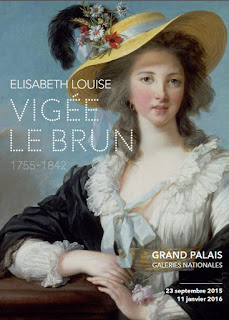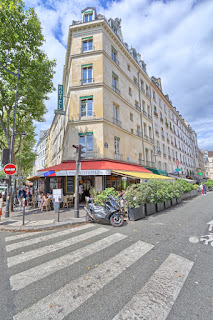Elisabeth Louise Vigée Le Brun au Grand Palais...
Au XIXème siècle, rares sont les femmes peintres connues et reconnues. Elisabeth Louise Vigée Le Brun va réussir par son talent, son oeil habile et son caractère, à s'imposer dans ce milieu masculin.
Initiée à la pratique de l'art par son père, Louis Vigée, la jeune française démontre très tôt son envie de peindre ses proches et sa façon de capter la réalité tout en y ajoutant une petite touche personnelle. Une des premières femmes à intégrer la grande Académie Royale de Peinture et de Sculpture, elle acquiert une méthode qu'elle mettra très vite au service de la Cour. A seulement 23 ans, elle devient le peintre officiel de Marie Antoinette. La reine aime en Elisabeth Louise Vigée Le Brun cette capacité à sublimer la réalité. L'artiste est une magicienne et son pinceau a la faculté de rendre beau chaque sujet. Les portraits de cette période dessinent une société avec ses fastes et ses humeurs. En parcourant l'exposition, on devient l'hôte du royaume.
Mais la Révolution sonne le glas et Elisabeth Louise Vigée Le Brun s'exile pour gagner l'Italie. Son voyage durera 12 années, loin de la France mais sans cesse d'une terre à l'autre, à la conquête des milieux aristocratiques étrangers. Elle n'éprouve aucune difficulté à vivre de ses toiles et gagne dès 1795 la Cour Impériale de Catherine II. Les portraits se suivent et lui rappellent Paris avant la période révolutionnaire. Son épopée se poursuit en Angleterre après un bref passage dans la Capitale française en 1802. Elle ne revient définitivement qu'en 1805 et ajoute à ses talents de portraitiste, ceux de paysagiste.
Au delà de la qualité indéniable de ses portraits, Elisabeth Louise Vigée Le Brun livre un témoignage historique incroyable. Peintre dans les plus grandes Cours, de la France à la Russie en passant par Vienne et Naples, elle a su immortaliser les bouleversements culturels et sociaux de son époque. On avance au gré des toiles de l'ancien Régime à l'Empire, et l'on voyage à ses côtés dans les plus belles sociétés...
Exposition Elisabeth Louise Vigée Le Brun
Jusqu'au 11 janvier 2016
Dormir à Saint-Germain des Prés, le temps d'une escapade culturelle.
In the nineteenth century, few women painters are known and recognized. Elisabeth Louise Vigee Le Brun succeeds by her talent, her clever eye and her character, to impose herself in this male environment.
Initiated to the art by her father, Louis Vigée, the French young girl demonstrates early her desire to paint relatives and her way of capturing reality while adding a personal touch. She is one of the first women to enter into the great Royal Academy of Painting and Sculpture, and she acquires a method that will very quickly lead her to the French Royal Court. At only 23, she becomes the official painter of Marie Antoinette. The queen loved in Elisabeth Louise Vigee Le Brun her ability to sublimate reality. The artist is a magician and her brush has the ability to make every subject beautiful. The portraits of this period draw a whole society with its splendor and moods. Walking through the exhibition, we become a host of the realm.
But the Revolution sounds the death knell and Elisabeth Louise Vigee Le Brun leaves for Italy. Her trip will last 12 years, far from France but constantly from one land to another, to conquer foreign aristocratic circles. She has no problem to live with her paintings and arrives in 1795 on the Imperial Court of Catherine II. She still paints portraits and it reminds her Paris before the revolutionary period. Her saga continues in England after a brief stint into the French capital in 1802. She returned permanently in 1805 and adds to his talents of portraits, those of landscape.
Beyond the undeniable quality of her portraits, Elisabeth Louise Vigee Le Brun gives an incredible historical testimony. Painter in major Courts, from France to Russia via Vienna and Naples, she has managed to capture the social and cultural upheavals of her time. We advance at the whim of paintings from before Revolution to the beginning of Empire and we travel with her in the best companies ...
*****
 |
| Marie-Antoinette |
Every year we look forward to the Grand Palais' program. What did it prepare this year ..? Which artists will be in the spotlights? And long queues at each exhibition learn about the permanent interest of visitors for the selected topics. Again, the monument proves his genius by inviting the unfairly unknown portraitist Elisabeth Louise Vigee Le Brun. And we highly recommend you to go and visit it before January 11, 2016, date of the end of the exhibition.
Initiated to the art by her father, Louis Vigée, the French young girl demonstrates early her desire to paint relatives and her way of capturing reality while adding a personal touch. She is one of the first women to enter into the great Royal Academy of Painting and Sculpture, and she acquires a method that will very quickly lead her to the French Royal Court. At only 23, she becomes the official painter of Marie Antoinette. The queen loved in Elisabeth Louise Vigee Le Brun her ability to sublimate reality. The artist is a magician and her brush has the ability to make every subject beautiful. The portraits of this period draw a whole society with its splendor and moods. Walking through the exhibition, we become a host of the realm.
But the Revolution sounds the death knell and Elisabeth Louise Vigee Le Brun leaves for Italy. Her trip will last 12 years, far from France but constantly from one land to another, to conquer foreign aristocratic circles. She has no problem to live with her paintings and arrives in 1795 on the Imperial Court of Catherine II. She still paints portraits and it reminds her Paris before the revolutionary period. Her saga continues in England after a brief stint into the French capital in 1802. She returned permanently in 1805 and adds to his talents of portraits, those of landscape.
Beyond the undeniable quality of her portraits, Elisabeth Louise Vigee Le Brun gives an incredible historical testimony. Painter in major Courts, from France to Russia via Vienna and Naples, she has managed to capture the social and cultural upheavals of her time. We advance at the whim of paintings from before Revolution to the beginning of Empire and we travel with her in the best companies ...
Elisabeth Louise Vigée Le Brun Exhibition
Until January 11, 2016



